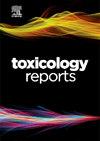Inhalation exposure to dihydroxyacetone promotes lung injury and pulmonary fibrosis in A/J mice
Q1 Environmental Science
引用次数: 0
Abstract
Acute and sub-acute exposure to dihydroxyacetone (DHA), a compound found in e-cigarette aerosols and spray tanning products, was assessed for its impact on lung injury in A/J mice. Mice were exposed to inhaled DHA doses of 5, 130, and 600 µg and evaluated at 1 and 24 h post-exposure. Acute exposure to DHA led to significant inflammatory responses, indicated by increased bronchoalveolar lavage fluid (BALF) protein levels at 5, 130, and 600 µg and notably elevated inflammatory cytokines IL-6 and TNF-α 1 h post-exposure. 24 h post-exposure, the 130 and 600 µg doses showed elevated BALF cell counts. Histological analysis revealed significant alveolar damage and increased lung injury scores for the 130 and 600 µg doses. For sub-acute exposure, male and female mice were exposed to 5 µg DHA for 14 days. Increased BALF cell counts and protein levels were observed, with sex-specific differences in cytokine responses. Male mice exhibited reduced levels of IFN-γ and TNF-α, while female mice showed significant lung damage characterized by decreased alveolar density and increased collagen deposition indicative of fibrosis. Functional assessments showed mixed obstructive and restrictive lung changes. This study highlights DHA’s potential to induce acute inflammatory responses and chronic lung damage, including both emphysematous and fibrotic changes. These findings suggest that DHA exposure, particularly from aerosolized e-liquids, could contribute to respiratory complications, underscoring the need for further research on long-term exposure effects.
吸入二羟基丙酮可促进A/J小鼠肺损伤和肺纤维化
研究人员评估了急性和亚急性暴露于二羟基丙酮(DHA)对a /J小鼠肺损伤的影响。二羟基丙酮(DHA)是电子烟气雾剂和喷雾晒黑产品中发现的一种化合物。小鼠吸入剂量分别为5,130和600 µg的DHA,并在暴露后1和24 h进行评估。急性暴露于DHA会导致显著的炎症反应,表现为暴露后支气管肺泡灌洗液(BALF)蛋白水平在5、130和600 µg时升高,炎症细胞因子IL-6和TNF-α 1 h显著升高。暴露后24 h, 130和600 µg剂量显示BALF细胞计数升高。组织学分析显示,130和600 µg剂量的肺泡损伤显著,肺损伤评分增加。对于亚急性暴露,雄性和雌性小鼠暴露于5 µg DHA 14天。观察到BALF细胞计数和蛋白水平升高,细胞因子反应存在性别特异性差异。雄性小鼠表现出IFN-γ和TNF-α水平降低,而雌性小鼠表现出明显的肺损伤,其特征是肺泡密度降低,胶原沉积增加,表明纤维化。功能评估显示混合性阻塞性和限制性肺改变。这项研究强调了DHA诱导急性炎症反应和慢性肺损伤的潜力,包括肺气肿和纤维化变化。这些发现表明,DHA暴露,特别是来自雾化电子液体的暴露,可能会导致呼吸系统并发症,强调需要进一步研究长期暴露的影响。
本文章由计算机程序翻译,如有差异,请以英文原文为准。
求助全文
约1分钟内获得全文
求助全文
来源期刊

Toxicology Reports
Environmental Science-Health, Toxicology and Mutagenesis
CiteScore
7.60
自引率
0.00%
发文量
228
审稿时长
11 weeks
 求助内容:
求助内容: 应助结果提醒方式:
应助结果提醒方式:


